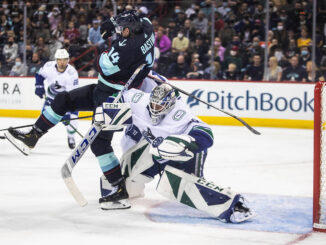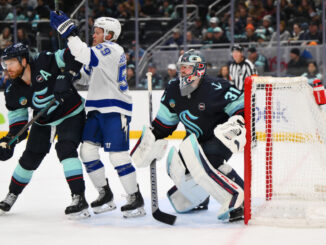
If I told you that the Seattle Kraken account for 52 percent of shot attempts at five-on-five, 53 percent of expected goals (including the third-best rate of expected goals against), and 53 percent of scoring chances, seeing the team at the bottom of the Pacific Division after 15 games becomes slightly confusing. On top of sub-par goaltending – the Kraken’s trio of Philipp Grubauer, Chris Driedger, and Joey Daccord have conceded a league-worst 14.2 goals above expected – their power play has, in a word, stunk. Let’s dig into how their units rank historically and what’s driving their abnormally poor finishing.
Seattle’s Power Play Is Historically Inefficient
In converting on only five of 46 total power play opportunities so far this season, the Kraken are the proud owners of a 10.9 percent success rate with the man advantage. For context, the 2020-21 Anaheim Ducks currently hold the record for the most futile power play over an entire season, capitalizing on only 8.9 percent of their opportunities.
Somehow this season’s Penguins are even worse, posting a conversion rate 0.2 percent lower than the historic mark, but it’s incredibly early, and both squads should eventually rack up a few more goals as their results regress to the norm. Some silver lining for fans of the Kraken?
Bad Luck or Low Chance Generation?
Anytime that we’re dealing with record-setting numbers, further inquisition is required. Are the Kraken’s struggles due to an unsustainably underwater shooting percentage, or are they just not creating enough quality looks to create a buffer against the volatility of a small sample of games? As it turns out, it’s a bit of column A, a bit of column B for the expansion franchise.
Unsurprisingly, Seattle’s shooting percentage (SH%) has tanked in parallel with their conversion rate, presenting a pitiful 7.14 SH% on the power play. In comparison, the red-hot Edmonton Oilers – who boast the NHL’s best-ever power play (41.9%, and yes, that won’t last) – have scored on a quarter of all of their shots on the man advantage. If the Kraken saw their shooting results creep up even a few percentage points to league-average, they’d rocket out of the historical infamy conversation.
Related: Three Factors Behind The Seattle Kraken’s Slow Start
So, we’ve established that Seattle has been slightly snake-bitten, but do they deserve an upswing in results based on their play on the ice? Their underlying numbers suggest that they shouldn’t be a bottom-five outfit, but that’s about where the charitable interpretations stop for the Kraken. They’ve generated bottom-third rates in terms of power play shot attempts, scoring chances, and expected goals for, so it appears their ceiling isn’t much higher than what’s been observed in the early results.
Kraken Limited by Offensively Stunted Roster
The consensus among industry pundits and fans alike was that the Kraken entered their inaugural season with a defensively sound but offensively stagnant roster. If the playoffs were in their immediate future, it would come on the backs of a dependable goaltending tandem and a robust defensive structure. So, the fact that Seattle is struggling to score is unsurprising to many – their lineup simply lacks many offensive weapons.
Jordan Eberle (43-goal pace), Jared McCann (41), and Brandon Tanev (33) are currently scoring at higher than a 20-goal pace, but none of them have ever been key pieces in a team’s offensive scheme. Whether they can continue to produce at the same clip remains to be seen, but the organization can’t point to a surefire source of goals at this point in time.
Where Does the Kraken Power Play Go from Here?
In short, they can only go up from here, and the return of Yanni Gourde gives Dave Hakstol another skilled forward to utilize on the man-advantage. Their underlying metrics on the power play aren’t even the worst this season, and such poor results are challenging to sustain over an entire season. Now, I’m sure the Ducks were singing the same refrain last year, but what are the odds that three of the NHL’s bottom-10 power plays ever are seen in consecutive seasons? Pretty low, right? Right?
Data via Hockey Reference, MoneyPuck, Natural Stat Trick, and the NHL. Statistics accurate as of November 16th.




